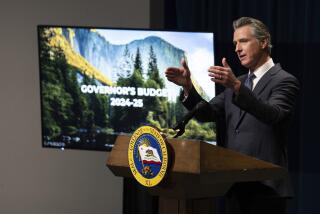In Shift, U.S. May Seek to Help Jobless Relocate : Economy: White House sees unlikely prospects for extension of benefits. State could lose skilled workers.
WASHINGTON — Pessimistic about the prospects of further extensions of jobless benefits, the Clinton Administration is planning a shift in approach that would help the long-term unemployed move from economically depressed regions to locales where job prospects are better.
The shift would be of particular interest to California, where unemployment is high--at nearly 10%--and where many of the jobless are unlikely to find jobs in their fields because of military base closures, a declining manufacturing sector and shrinking defense and aerospace industries.
For the record:
12:00 a.m. Dec. 1, 1993 For the Record
Los Angeles Times Wednesday December 1, 1993 Home Edition Part A Page 3 Column 5 Metro Desk 2 inches; 37 words Type of Material: Correction
Jobless benefits--Because of an editing error, a story in Tuesday’s editions on White House plans to encourage relocation of the unemployed misstated the length of the most recent extension of unemployment benefits in California. The correct period is 13 weeks.
Labor Secretary Robert B. Reich said Monday that the recent congressional battle over extending unemployment benefits to people whose regular benefits had lapsed demonstrated that there is little money or political support for additional aid--much of which goes to people who continue looking for work in their region while waiting for the economy to improve.
“The cupboard is practically bare,” Reich said in a meeting with a small group of reporters.
Instead, Administration officials are working on legislation seeking to provide better information to unemployed people across the country about job prospects and training opportunities in other regions.
Legislation the Administration intends to introduce next year would coordinate various federal and state job training opportunities so that structurally unemployed individuals are aware of a wider range of options. It would also set up an improved information network so that people who have lost their jobs can determine if their skills are in demand elsewhere in the country.
Such a system could add to the already large out-migration of skilled workers from California in recent months, state officials said.
“What they are doing is trying to encourage mobility to try to encourage people who are in depressed areas to move,” said Ted Gibson, principal economist at the California Finance Department. “Mobility has traditionally been one of the ways we’ve solved our unemployment problems in America. Over the last century, California has usually been a beneficiary.”
Dating back as far as the Gold Rush of 1848, when thousands flocked to California in search of riches and stayed on to take other jobs, the state has enjoyed an influx of job seekers.
In the 1930s, a half million desperate people journeyed to the state, fleeing dust bowl conditions in Oklahoma, Arkansas, Texas and Missouri. In the 1950s, with the decline of heavy industry in the Midwest, workers streamed into California. And in the mid 1980s, when the “oil patch” states were in an economic slump, many people migrated to Texas.
But in recent years, with the stubborn recession in California and the structural changes in the state’s economy, the tide has shifted. Last year, 150,000 native-born Americans left the state, and from July to October the exodus was running at an annual rate of a quarter million, Gibson said.
“We presume that people are leaving because they are having job problems,” Gibson said. “The people whose jobs have been lost and who are likely to move are highly skilled people, and California does not want to lose them.”
The movement of workers out of depressed areas is hardly a rare occurrence in American history, but it has traditionally been viewed as a politically sensitive topic and politicians have avoided candid discussions about it. They have been inclined, instead, to stress that things will get better if only their constituents would have patience.
With the huge changes going on in the structure of the work force in California and elsewhere, such optimism seems Pollyannaish to many.
State and federal officials are struggling to deal with a new reality where a big percentage of those who lose their jobs will not be rehired by their companies or in their fields.
Although it is not clear where jobs will come from in the future, California officials stress that extension of federal unemployment compensation is especially important for the structurally unemployed.
“In a time when we have changing economic factors due to decisions made by the federal government, we are looking to the federal government to help mitigate the consequences,” Anita Grandrath Gore of the California Employment Development Department said. “The governor has encouraged the federal government to continue extending unemployment compensation for states like California.”
Three extensions of the benefit for long-term unemployed were approved during the George Bush Administration, and two have been approved under President Clinton. But getting the last one through Congress was difficult. The latest extension, a $1-billion measure approved just before Congress recessed for the year, was approved after a tough fight in the Senate. At one point it was hung up over demands for new cost savings from reduced federal employment.
The chances of pushing another benefits package through are “doubtful,” Reich said.
The latest extension enabled California workers who exhausted their initial 26 weeks of benefits to continue receiving unemployment compensation for another 26 weeks. If the federal expansions cease, approximately 50,000 people a month will lose benefits in California, Gore said.
Considering the state’s fiscal problems, the only way it could compensate its jobless residents would be to force employers to pay higher taxes, which would hurt the job market because employers then would be less likely to hire new workers, she said.
“Los Angeles would be hit especially hard, because of the sheer size of its labor force,” she added.
The state Employment Development Department has just launched a program to help identify people who are unemployed and unlikely to be rehired because of changes in the structure of the economy and to refer them to training programs.
But despite the intentions, the effects the new state and planned federal programs would have on California are unclear. “People with good skills are aware of the economic conditions in the country and do not need a push from the government to move,” Gibson, the California Finance Department official, said.
The Los Angeles and San Francisco areas are so expensive to live in, he said, that people who are unemployed for a long period of time do not have a choice but to move, even if they receive unemployment benefits.
But the combination of no more extensions and improved resources for finding and preparing for jobs elsewhere is likely to change the thinking of at least some unemployed people who were planning to stay in California hoping for better times.
“It might give them less reason to stick it out,” Gibson said.
More to Read
Get the L.A. Times Politics newsletter
Deeply reported insights into legislation, politics and policy from Sacramento, Washington and beyond. In your inbox three times per week.
You may occasionally receive promotional content from the Los Angeles Times.










